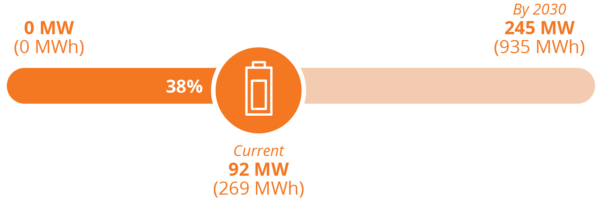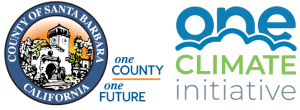Overview
One way of providing energy assurance is reducing energy demand while increasing local energy supply and storage options to minimize disruptions that can occur in delivering electricity from where it is generated to where it is consumed. Adding distributed energy resources—like onsite solar and batteries—that connect with the local distribution grid provides the greatest energy assurance benefit. Continuing to build larger utility-scale renewable energy generation and energy storage projects in the county is important, too. The Santa Barbara County Energy Assurance Map shows how we are increasing the supply of carbon-free renewable energy and energy storage projects. We can also strengthen energy assurance by designing and retrofitting buildings to be able to stay powered, safe, and comfortable during climate change-driven power outages and events.
The County of Santa Barbara has a long history of supporting energy conservation and new renewable energy development, both for County facilities and the community. The County is building on this experience with the following goals to match the urgency of the climate crisis and the need for a reliable, resilient, community-powered energy system.
These energy assurance goals were established in 2024 and may be updated as progress is made. To learn more about how you can support reaching these goals, please visit www.ClimateResilientSBC.org.
Goals
Goal 1
Increase renewable energy capacity
By 2030, there will be 700 MW of renewable energy in Santa Barbara County. This goal is disaggregated into two parts:
- By 2030, there will be 250 MW of utility scale renewable energy.
- By 2030, there will be 450 MW of distributed (small scale) solar energy, equal to 1 kW per person.

Goal 2
Increase energy storage capacity
By 2030, there will be 245 MW (935 MWh) of energy storage in Santa Barbara County. This goal is disaggregated into two parts:
- By 2030, there will be 200 MW (800 MWh) of utility scale energy storage in the county.
- By 2030, there will be 45 MW (135 MWh) of distributed (small scale) energy storage, equal to 0.1 kW (0.3 kWh) per person.

Goal 3
Increase demand response program participation
By 2030, 115,000 Santa Barbara County electricity customers will participate in a demand response program offered by PG&E or SCE.

Goal 4
Increase community resilience hubs with backup power
By 2030, there will be 10 community resilience hubs with backup power throughout Santa Barbara County.

Baseline versus Goal Comparison
2023 Baseline Values and 2030 Target Values
Tracking Our Progress
The County will monitor and report progress on achieving the energy assurance goals as part of annual reporting on the Climate Action Plan and/or Climate Change Adaptation Plan. Monitoring will be completed by appropriate staff within each lead department and documented in the 2030 CAP Implementation Plan that is managed by the Sustainability Division.
Additionally, the County will update the Santa Barbara County Energy Assurance Map annually to show changes in installed renewable energy and energy storage systems over time. The map will prioritize investments in strategies that can help address energy assurance gaps measured by low concentrations of renewable energy and energy storage systems by zip code, focusing on communities most vulnerable to power outages.
